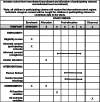Study protocol: Evaluation of the 'Flavour School' sensory food education programme: a cluster-randomised controlled trial in UK primary school children, aged 4-7 years, to determine impact on confidence and curiosity in tasting vegetables and fruit
- PMID: 36002844
- PMCID: PMC9399583
- DOI: 10.1186/s13063-022-06612-2
Study protocol: Evaluation of the 'Flavour School' sensory food education programme: a cluster-randomised controlled trial in UK primary school children, aged 4-7 years, to determine impact on confidence and curiosity in tasting vegetables and fruit
Abstract
Background: Many children would benefit from a diet richer in vegetables and fruit. 'Flavour School' is a programme of 'sensory food education', which aims to increase children's confidence and curiosity in exploring foods and flavours, especially vegetables and fruit. This study will conduct a cluster-randomised controlled trial to assess the outcomes of the Flavour School programme in primary school children aged 4-7 years.
Methods: Four hundred plus children from 4+ schools will either complete the Flavour School programme (experimental group) or have no intervention with normal school teaching (control group), cluster-randomised within-schools, by school class. Baseline data collection will consist of video recorded behavioural observation during a tasting activity, and post-intervention data collection will repeat this activity after the experimental group have completed the intervention. Process measures will be assessed using a teacher engagement feedback questionnaire.
Discussion: This study will provide causal data on the efficacy of a sensory food education intervention for increasing children's confidence and curiosity in exploring foods and flavours, especially vegetables and fruit. This new knowledge will help educators and policy makers to make evidence based decisions on uptake of sensory food education.
Trial registration: ISRCTN: 40249947 Date assigned 17 March 2020 Last edited 22 September 2021 Version 1.2 Trial Acronym OASES (Outcomes Assessment of Sensory Education in Schools).
Keywords: Children; Cluster-randomised controlled trial; Diet; Fruit and vegetables; Health; Intervention; Primary school; Sensory food education.
© 2022. The Author(s).
Conflict of interest statement
NMW is a co-founder and trustee of Flavour School. Flavour School is committed to an evidence based approach, of which this study is one aspect. NMW does not stand to benefit financially or in kind based on the results of this study.
The other authors declare that they have no competing interests.
This study has received financial support from Flavour School, funded by a grant from Ella's Kitchen (UK company no. 5183743). This funding will cover costs to participating schools of buying fresh produce for the food education intervention. Ella’s Kitchen are advocates of sensory food education. Ella’s Kitchen have no influence over the conduct of the study or over decisions of what results to publish.
Figures




References
-
- Robertson A, et al. Food and health in Europe: a new basis for action. WHO Reg Publ Eur Ser. 2004;(96):i–xvi 1-385, back cover. - PubMed
Publication types
MeSH terms
Grants and funding
LinkOut - more resources
Full Text Sources
Medical

